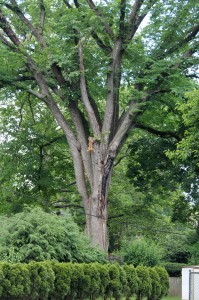Microbursts, Ticks, Etc.
June 5th, 2012
Here’s hoping you didn’t lose any trees or big branches in those stormy “microbursts” the area has seen in the last week and a half.
Joel Burcat’s nearly century-old American elm — one of the few in the Harrisburg area to survive Dutch elm disease — didn’t fare too well in one of them.
Already compromised and hurting from a lightning strike a couple of years ago, the tree lost one of its last remaining big limbs in a storm last week. The limb brought down power lines and smashed a swath of Joel’s landscaping in the process.
Three more branches are injured, and the tree company says the old survivor elm is beyond salvaging now.
It’s actually amazing that more of our landscapes aren’t flattened when these powerful storms blow through.
I was watching a 30-year-old dogwood in my back yard get whipped around violently earlier this evening in a storm that was packing 60 mph winds. The branches were flying around like bull whips, yet it came out unscathed — except for a couple of little bits of dead wood that fell out.
That’s a good lesson in why it’s important to thin out some of the excess branches in growing trees (at least the ones you’d like to keep into old age). More open trees let the wind blow through instead of create what amounts to a big sail made out of a lot of leaves.
Other than the quick-hit storms, the weekend was one of the nicest we could ask for this time of year. Sunny. Pleasant. Low humidity. I didn’t even see many black flies.
Ticks, yes. Black flies, no.
This has been by far the worst spring I’ve seen for ticks. My wife works in a medical clinic, and she says they’ve been getting a lot of people coming in to have embedded ticks removed.
Part of it is the warm winter we had. Ticks not only weren’t snowed under, they were active for much of winter. That’s very unusual.
In my case, I’m bordered on two sides by untended yards — a favorite habitat for tick breeding. The worst is the yard beside me, where the couple split up and ended up just walking away.
The place now hasn’t been mowed in a year and a half. Ever wonder what happens to a typical suburban yard when you don’t mow it for a year and a half?
I can tell you that turfgrass actually grows to about waist high, and trees-of-heaven can go from seed to 8 feet tall almost overnight.
Weeds of all kinds quickly grow up and over perennials and shrubs and smother them. In less than 2 years, in other words, a yard will go from “landscape” to tick-infested jungle.
The township can’t even figure out whom to cite. Apparently, mortgages in arrears get sold and resold over and over again.
But getting back to ticks, don’t forget to check yourself every time you come back inside from gardening.
The smaller black-legged tick — the one responsible for transmitting Lyme disease — is the one you really don’t want to let latch on. (People often call it a “deer tick” even though it’s usually more often carried around by rodents.)
The more common and so-called “dog tick” isn’t quite as threatening, but it also can transmit disease. Either way, who wants a bug burrowed into their head?
If you’re not up on ticks, here’s a link to a piece I wrote for The Patriot-News, based on advice from Penn State’s leading tick expert: https://georgeweigel.net/favorite-past-garden-columns/tick-alert.
For details on identifying, preventing and removing ticks as well as details on Lyme disease, check out the U.S. Centers for Disease Control’s web site on ticks at http://www.cdc.gov/ticks.
And for everything you ever wanted to know about ticks and their management, see the state of Connecticut’s Tick Management Handbook at http://www.ct.gov/caes/lib/caes/documents/publications/bulletins/b1010.pdf.









